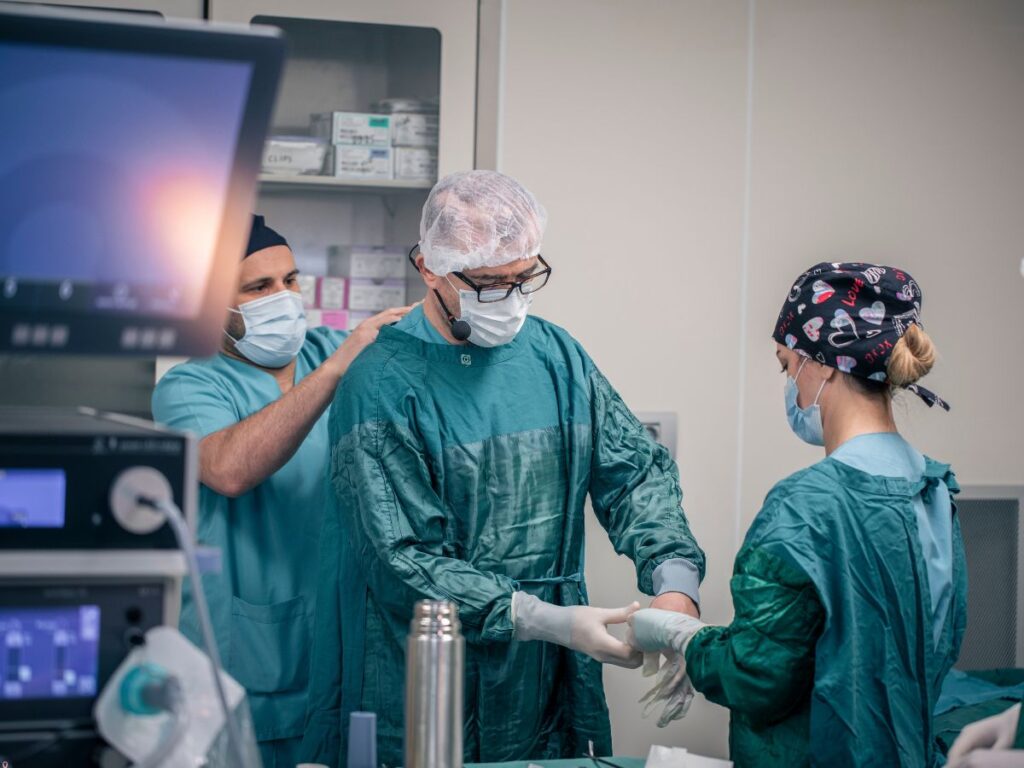Why Post-Rotator Cuff Rehab Is Critical
Rotator cuff surgery addresses torn or frayed tendons in the shoulder, offering relief from persistent pain and instability. Yet the surgical fix alone can’t ensure a full return to normal arm function. Following the operation, you face a window where scar tissue can hamper motion, while weakened shoulder muscles struggle to stabilize overhead movements. Specialized rehab counters these issues, guiding you through deliberate exercises that restore tendon integrity, build strength, and prevent compensatory flaws. Without it, the repaired rotator cuff may remain vulnerable, leaving you stuck in guarded movements or still plagued by pain for months or years to come.
Common Post-Surgery Roadblocks
Early on, the shoulder remains swollen and sensitive, often immobilized in a sling. The repaired cuff muscles—supraspinatus, infraspinatus, subscapularis, or teres minor—demand cautious activation so they don’t re-tear. Scar tissue can rapidly stiffen the joint if not addressed through gentle mobilization. Fear of pain or reinjury might tempt you to keep the shoulder immobile, further fueling atrophy and limiting range of motion. Structured rehab systematically overcomes these hurdles, first easing inflammation, then re-engaging muscles in controlled increments until the cuff can reliably support overhead or rotational tasks without straining.
Core Phases of Rotator Cuff Rehab
While protocols differ, rehabilitation typically spans:
- Protected Mobilization: Passive range-of-motion exercises where a therapist moves the arm, preventing stiffening while sparing the fragile tendon repair.
- Gradual Strengthening: Light resistance exercises—like external rotations with a band—progressively rebuild cuff resilience.
- Scapular Stabilization: Anchoring the shoulder blade fosters a stable platform for arm movement.
- Functional Drills: As healing solidifies, simulated activities (like lifting moderate objects) reacquaint the cuff with real-life loads.
- Endurance and Coordination: Advanced steps that refine overhead reach or precise arm control, culminating in normal or athletic usage.
Each stage ensures tissues mend without undue stress, inching you toward confident, pain-free arm function for daily chores or recreational endeavors.
Dr. Elham’s Holistic Help
Dr. Elham’s chiropractic perspective complements standard shoulder rehab by spotting subluxations in the thoracic spine or neck that hamper cuff mechanics. A stiff upper back or misaligned scapula can hamper overhead range, forcing the freshly repaired tendon to overcompensate. Gentle manipulations around the spine or scapular region enhance synergy, letting rehab exercises perform smoothly. If stress or other posture issues linger, Dr. Elham suggests mindful alignment checks or brief scapular retractions, reducing the risk of muscle tension that re-strains the rotator cuff. This synergy fosters a more stable, cooperative shoulder environment throughout rehab.
Post-Op Rotator Cuff Rehab Benefits
Adhering to a structured program affords multiple rewards:
- Protected Tendon Healing: Gradual exercises strengthen the cuff without tearing fragile sutures.
- Preventing Frozen Shoulder: Early, gentle movement thwarts capsule stiffness and scarring.
- Smoother Overhead Reach: As tissues adapt, raising arms overhead or behind the back becomes more comfortable.
- Reduced Persistent Pain: Balanced scapular and rotator cuff function decreases tension that triggers lingering aches.
- Return to Sport or Work: Proper strengthening enables safe reentry into tasks demanding arm power or endurance.
Ultimately, robust rehab ensures the repaired tendon becomes a reliable cornerstone of your shoulder’s movement, rather than a lingering weak link prone to re-injury.
Self-Care Beyond Therapy
Between clinic sessions, Dr. Elham and your therapist likely prescribe short home exercises—like passive arm raises or gentle band rotations. Avoid pushing overhead motions too soon, as the tendon needs methodical buildup. If discomfort flares, applying ice can calm inflammation. Sleep positioning matters—many prefer a slightly elevated torso or use pillows to limit painful rolling. Gradual, mindful approach ensures you retain session gains, while preventing hasty moves that might strain the healing cuff. Over weeks, these at-home routines blend into daily life, securing lasting shoulder stability and range.
Tackling Real-World Challenges
Even mundane tasks—like reaching into a cupboard or adjusting a car mirror—can spark anxiety post-rotator cuff surgery. Rehab addresses these functional obstacles in a progressive manner. Once basic strength returns, therapy simulates overhead lifting of lightweight objects or controlled pushing motions. Dr. Elham’s posture checks ensure the neck and scapula remain balanced, reducing abnormal stresses on the cuff. As milestones accumulate, tasks like carrying groceries or returning to certain sports become feasible again, accompanied by a sense of accomplishment and renewed trust in your shoulder’s capacity.
If Rehab Is Overlooked
Without structured therapy, the surgically mended tendon can re-adhere incorrectly, limiting range of motion or inviting re-tears under mild stress. Scar tissue might freeze the joint, fueling daily aches and undermining surgical benefits. Weak muscles can’t stabilize overhead gestures, raising risk for secondary injuries to the biceps tendon or cervical spine. In some cases, extended immobility or repeated strain on an unrehabbed cuff triggers chronic inflammation that demands further intervention. By dedicating time to purposeful rehab, you shield your surgery’s success and lock in a pain-free, stable shoulder for the long haul.
Typical Therapy Progression
Initially, you might remain in a sling, doing only passive range of motion (therapist-assisted or using the opposite arm). As weeks pass, you phase into active-assisted drills, gently guiding your own arm in arcs or lifts. Strength steps begin with minimal resistance—like isometric holds or light bands—focusing on external and internal rotation. Core or scapular stability work ensures overhead motions stay controlled. Dr. Elham might adjust upper back vertebrae if posture deficits hamper scapular positioning. Eventually, therapy includes functional lifts—like slowly raising a light dumbbell overhead—to confirm the rotator cuff can handle real-life loads minus pain or impingement.
Emerging with a Fully Repaired Shoulder
Rehab after rotator cuff surgery transitions your shoulder from a surgically patched tendon to an integrated, high-function joint. Each stage—passive mobilizations, gradual strengthening, scapular balance—reinforces the surgeon’s repair by nurturing healthy muscle synergy and precise alignment. Dr. Elham’s adjustments and posture guidance address broader mechanical issues, eliminating potential friction points that sabotage cuff healing. Over a few months, what began as guarded movements evolve into fluid, confident range, freeing you to reach overhead, lift moderate objects, or perform daily tasks comfortably. In essence, robust rehabilitation ensures your repaired cuff stands the test of time, letting you reclaim everyday activity and, if desired, moderate sports or active recreation without the specter of repeating old injuries.






